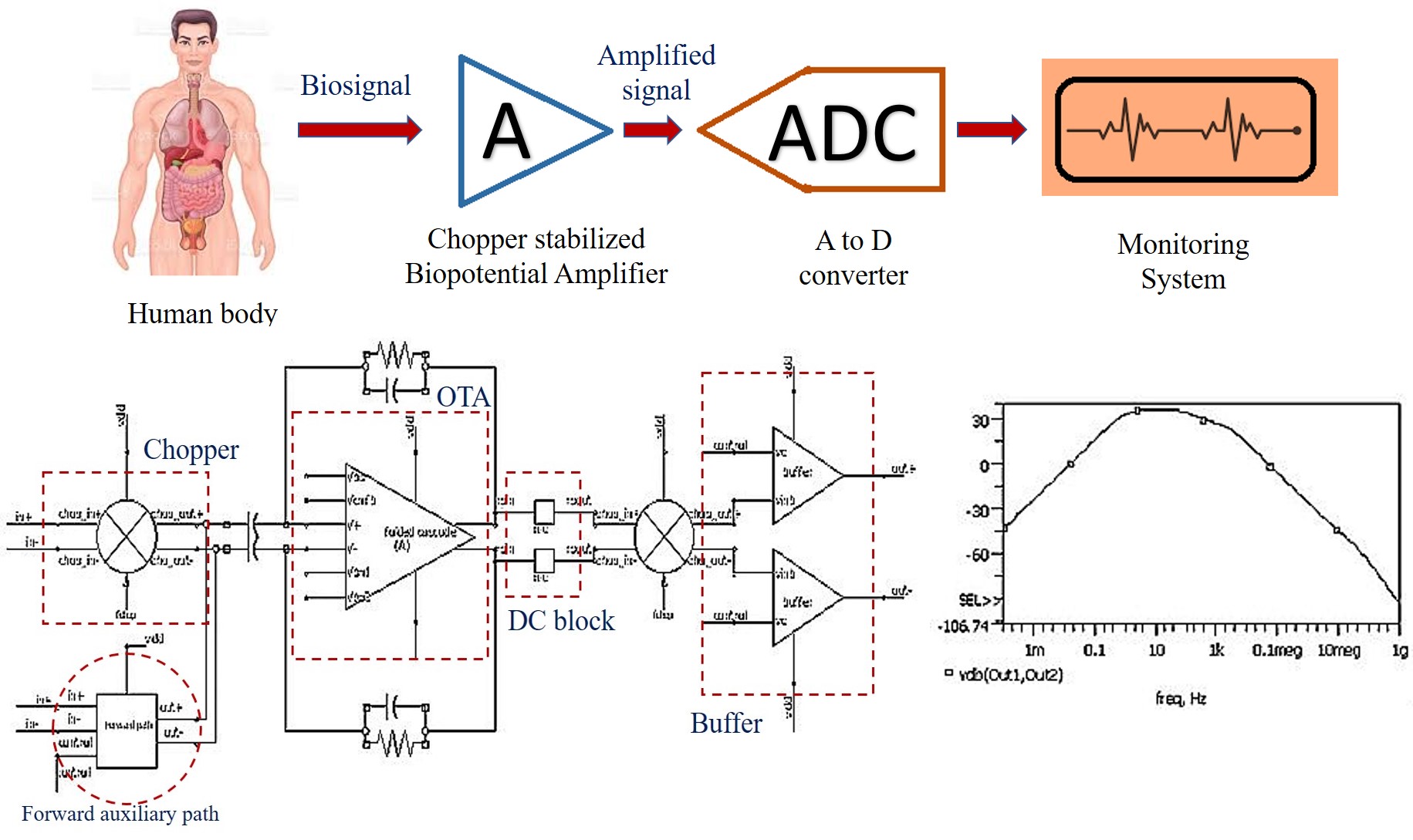A Low Noise High Input Impedance Chopper-Stabilized Biopotential Amplifier with Ripple Reduction Technique
DOI:
https://doi.org/10.48048/wjst.2021.23974Keywords:
Biopotential amplifier, Chopper stabilization, Electrocardiogram, Noise, RippleAbstract
Biopotential signals are created as a result of the electrochemical activity of the many cells that comprise the nervous system, and they represent both normal and pathological organ function. These signals must be identified with extreme caution because they are surrounded by a great deal of noise when detected by sensors. This article explores a novel biopotential amplifier that incorporates the chopper stabilization technique to increase noise performance and minimize offset. However, by introducing the chopper modulator into the proposed design, the amplifier's overall input impedance was lowered, which was then increased to greater than 200 MΩ by adding the forward auxiliary path to the input branch. Additionally, the output ripple, produced due to switching activity and up-sampling, was reduced by inclusion of the R-C ripple removing block at the output of the operational transconductance amplifier (OTA). The designed architecture had a mid-band gain of 40dB with a power consumption of 9 µW and an offset of 10µV and a CMRR of 82 dB. It generated a noise of 42nV/√Hz. Also, the obtained results were compared with a conventional amplifier. The proposed design was verified by carrying out simulations using 180nm technology parameters. Cadence Virtuoso (Schematic editor), Spectre (Simulator), Symica and Magic (Layout) tools were used to complete the implementation and simulation of the proposed design.
HIGHLIGHTS
- Biopotential signals are created as a result of the electrochemical activity of the many cells which must be identified with extreme caution because they are surrounded by a great deal of noise when detected by sensors
- It explores a novel biopotential amplifier that incorporates the chopper stabilization technique to increase noise performance and minimize offset
- By introducing the chopper modulator into the proposed design, the amplifier's overall input impedance was lowered, which was then increased to greater than 200 MΩ by adding the forward auxiliary path to the input branch
- The output ripple, produced due to switching activity and up-sampling, was reduced by inclusion of the R-C ripple removing block at the output of the operational transconductance amplifier (OTA)
- The designed architecture had a mid-band gain of 40dB with a power consumption of 9 µW and an offset of 10 µV and a CMRR of 82 dB. It generated a noise of 42 nV/√Hz
GRAPHICAL ABSTRACT
Downloads
Metrics
References
CJ Lee and JI Song. A chopper stabilized current-feedback instrumentation amplifier for EEG acquisition applications. IEEE Access 2019; 7, 11565-9.
S Chauhan and LM Saini. Low power and low noise instrumentation amplifier. In: Proceedings of the 2nd International Conference on Intelligent Computing and Control Systems, Madurai, India. 2018, p. 1332-5.
H Chandrakumar and D Markovic. A high dynamic-range neural recording chopper amplifier for simultaneous neural recording and stimulation. IEEE J. Solid-State Circuits 2017; 52, 645-56.
RR Harrison and C Charles. A low-power low-noise CMOS amplifier for neural recording applications. IEEE J. Solid-State Circuits2003; 38,958-65.
H Chandrakumar and D Markovic. A simple area-efficient ripple-rejection technique for chopped biosignal amplifiers. IEEE Trans. Circuits Syst. II Express Briefs 2015; 62, 189-93.
J Wu, MK Law, PI Mak and RP Martins. A 2-μW 45-nV/√Hz readout front end with multiple-chopping active-high-pass ripple reduction loop and pseudofeedback DC servo loop.IEEE Trans. Circuits Syst. II Express Briefs2016; 63, 351-5.
AChandrakasan.Integrated circuits and systems. Springer Fachmedien Wiesbaden GmbH, Wiesbaden, Germany, 2014.
Y Agrich, V Lifshits, Y Pavlyuk, I Gureev and D Vorobyev. CMOS amplifier with chopper stabilization and offset calibration. In: Proceedings of the IEEE Conference of Russian Young Researchers in Electrical and Electronic Engineering, St. Petersburg and Moscow, Russia. 2020, p. 2336-9.
A Bagheri, MT Salam, JLP Velazquez and R Genov. Low-frequency noise and offset rejection in dc-coupled neural amplifiers: A review and digitally-assisted design tutorial. IEEE Trans. Biomed. Circuits Syst. 2017; 11, 161-76.
Q Fan, F Sebastiano, JH Huijsing and KAA Makinwa. A 1.8 μ W 60 nV/√ Hz capacitively-coupled chopper instrumentation amplifier in 65 nm CMOS for wireless sensor nodes. IEEE J. Solid-State Circuits 2011; 46, 1534-43.
J Xu, RFYazicioglu, B Grundlehner, P Harpe, KAA Makinwa and CV Hoof. A 160 μW 8-channel active electrode system for EEG monitoring.IEEE Trans. Biomed. Circuits Syst. 2011; 5, 555-67.
R Burt and J Zhang. A micropower chopper-stabilized operational amplifier using a SC notch filter with synchronous integration inside the continuous-time signal path. In: Proceedings of the IEEE International Solid-State Circuits Conference, San Francisco, CA, USA. 2006, p. 386-7.
P Bruschi, FD Cesta, AN Longhitano, M Piotto and R Simmarano. A very compact CMOS instrumentation amplifier with nearly rail-to-rail input common-mode range. In: Proceedings of the 40th European Solid State Circuits Conference, Venice Lido, Italy.2014, p. 323-6.
GT Ong and PK Chan. A power-aware chopper-stabilized instrumentation amplifier for resistive Wheatstone bridge sensors.IEEE Trans. Instrum. Meas. 2014; 63, 2253-63.
MG Jomehei and S Sheikhaei. A low-power low-noise CMOSbio-potential amplifier for multi-channel neural recording with active DC-rejection andcurrent sharing. Microelectronics J. 2019; 83, 197-211.
Downloads
Published
How to Cite
Issue
Section
License

This work is licensed under a Creative Commons Attribution-NonCommercial-NoDerivatives 4.0 International License.













